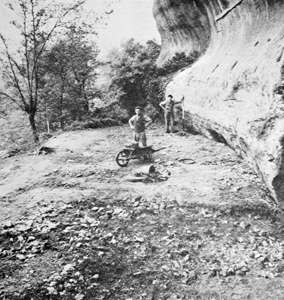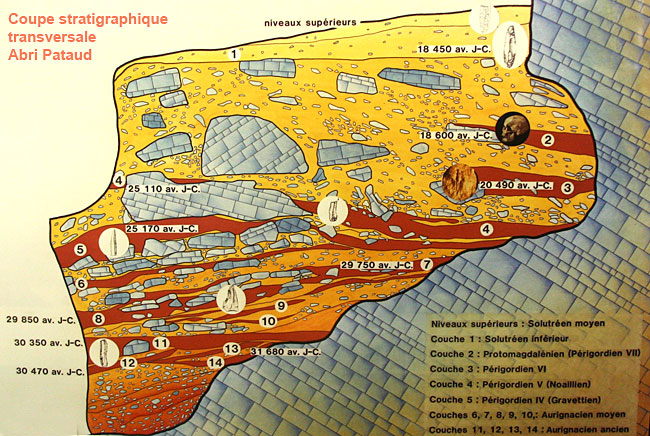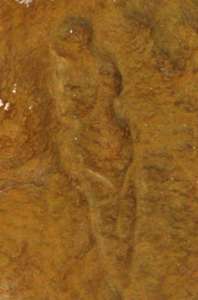It looks like you're using an Ad Blocker.
Please white-list or disable AboveTopSecret.com in your ad-blocking tool.
Thank you.
Some features of ATS will be disabled while you continue to use an ad-blocker.
11
share:
Abri Pataud is a cave, located in a limestone cliff overlooking a River in the Dordogne valley of France. The site has important Upper Paleolithic
occupations dated between 22,000 and 40,000 years ago. A marvelous site, I visited here in 2002 while traveling through the more important sites in
South west france and of course including a pilgrimage to the replica of famous Lascaux
Abi Patuad after the excavation

The site before they began to excavate in earnest

A diagram of the layers found within it (in French)

•Level 1, 24,300 cal BP, Lower Solutrean
•Level 2, 26,300 cal BP, Final Gravettian (or ProtoMagdalenian) with large blades and backed bladelets
•Level 3, 29,325 cal BP, Recent Gravettian with Microgravette points
•Level 4, 30,000-32,000 cal BP, Middle Gravettian, with Noailles burins and Raysse burins facies
•Level 5, 31,960-34,110 cal BP, Early Gravettian (Perigordian), with Gravette points and flechettes de Bayac
•Level 6, 36,200-36,730 cal BP, Aurignacian, between II and IV technocomplexes
•Level 7, 36,640-37,320 cal BP, Aurignacian II, burins and burins busqués
•Level 8, 36,700-37,880 cal BP, Aurignacian II, dominated by scrapers including nose-ended scrapers and Dufour bladelets
•Levels 9-14, 37,000-42,000 cal BP, Early Aurignacian, predominant scrapers, especially carinate scrapers and retouched blades, including Aurignacian blades.
Summary of the site
Extensive website on the excavation with full explanation and lots of images
One of the most famous objects found The Venus of Abri Pataud

Abi Patuad after the excavation

The site before they began to excavate in earnest

A diagram of the layers found within it (in French)

•Level 1, 24,300 cal BP, Lower Solutrean
•Level 2, 26,300 cal BP, Final Gravettian (or ProtoMagdalenian) with large blades and backed bladelets
•Level 3, 29,325 cal BP, Recent Gravettian with Microgravette points
•Level 4, 30,000-32,000 cal BP, Middle Gravettian, with Noailles burins and Raysse burins facies
•Level 5, 31,960-34,110 cal BP, Early Gravettian (Perigordian), with Gravette points and flechettes de Bayac
•Level 6, 36,200-36,730 cal BP, Aurignacian, between II and IV technocomplexes
•Level 7, 36,640-37,320 cal BP, Aurignacian II, burins and burins busqués
•Level 8, 36,700-37,880 cal BP, Aurignacian II, dominated by scrapers including nose-ended scrapers and Dufour bladelets
•Levels 9-14, 37,000-42,000 cal BP, Early Aurignacian, predominant scrapers, especially carinate scrapers and retouched blades, including Aurignacian blades.
Among the important findings at the cave is the Gravettian in evidence at Level 5. Movius' excavations identified a main occupation zone hidden behind a rock fall at the back of the cave, and a refuse midden at the front, where animals were butchered and animal skins were processed. More than 300 pieces of human bone were recovered from the Gravettian layer, all of which belong to Anatomically Modern Humans (AMH). Among these are a complete skull and mandible.
Summary of the site
Extensive website on the excavation with full explanation and lots of images
One of the most famous objects found The Venus of Abri Pataud

edit on 6/2/12 by Hanslune because: (no reason given)
Great Post, Hans.
S&F!!
The donsmaps page on the Venus of Abri and other finds detailed with photographs is such a great site.
S&F!!
The donsmaps page on the Venus of Abri and other finds detailed with photographs is such a great site.
reply to post by coredrill
What I found most interesting is that this cave was used only by modern men and not Neanderthal. However the excavator did one very good thing, he left a portion of the cave untouched - knowing that future archaeologists with better technology and knowledge would have untouched material to look at.
What I found most interesting is that this cave was used only by modern men and not Neanderthal. However the excavator did one very good thing, he left a portion of the cave untouched - knowing that future archaeologists with better technology and knowledge would have untouched material to look at.
Originally posted by Hanslune
reply to post by coredrill
What I found most interesting is that this cave was used only by modern men and not Neanderthal. However the excavator did one very good thing, he left a portion of the cave untouched - knowing that future archaeologists with better technology and knowledge would have untouched material to look at.
Is that common practice?
It is certainly an extremely beneficial act by the excavator!
I have wondered before about the caves in France with regards to periods of use. For example Vercingetorix using caves as shelters from the Romans. I have thought that these places may be worth searching for items from the lost period of history in Europe, after the Hunnish invasion. The Huns were known to fear underground areas and as such would have been perfect places to take refuge with whatever valuables could be stored!
Anyhow, off the speculation front and back to facts. Is there any indications as to the age of the unexcavated part? Is it in the furthest part of the cave? (indicating the oldest part).
Nice post. I live only 30k from these caves and have still not taken the time to visit! But its to my understanding that you are not allowed in the
original caves anymore which is a real shame. Instead they have some form of replica for tourists.
I guess if thats what it takes to preserve the originals then its the best thing to do. We wouldnt want one of the oldest human settlements corrupted by out modern 'sticky fingers'.
I guess if thats what it takes to preserve the originals then its the best thing to do. We wouldnt want one of the oldest human settlements corrupted by out modern 'sticky fingers'.
Originally posted by Flavian
knowing that future archaeologists with better technology and knowledge would have untouched material to look at.
Is that common practice?
It is certainly an extremely beneficial act by the excavator!
It is now back when he finished up it wasn't - that or he ran out of time or money!
I have wondered before about the caves in France with regards to periods of use. For example Vercingetorix using caves as shelters from the Romans. I have thought that these places may be worth searching for items from the lost period of history in Europe, after the Hunnish invasion. The Huns were known to fear underground areas and as such would have been perfect places to take refuge with whatever valuables could be stored!
Anyhow, off the speculation front and back to facts. Is there any indications as to the age of the unexcavated part? Is it in the furthest part of the cave? (indicating the oldest part).
Let me look - its in the Don's Map link
Originally posted by Hanslune
reply to post by coredrill
What I found most interesting is that this cave was used only by modern men and not Neanderthal. However the excavator did one very good thing, he left a portion of the cave untouched - knowing that future archaeologists with better technology and knowledge would have untouched material to look at.
That's an exciting idea. It's a beautiful find, and thank you for the documentation. I'm not sure how many people actually lived inside caves before the rise of civilization -- do you have any idea? Here in the Southwest, the living areas are generally rock shelters (overhangs of rock) and not caves.
reply to post by Byrd
I've seen speculation that people lived there only when making hunting expeditions to specific places or in the times of bad weather.
My experience is that caves have limitations, especially those in limestone formations (they leak). But they are might good for keeping out bad guys and animals
That's an exciting idea. It's a beautiful find, and thank you for the documentation. I'm not sure how many people actually lived inside caves before the rise of civilization -- do you have any idea? Here in the Southwest, the living areas are generally rock shelters (overhangs of rock) and not caves.
I've seen speculation that people lived there only when making hunting expeditions to specific places or in the times of bad weather.
My experience is that caves have limitations, especially those in limestone formations (they leak). But they are might good for keeping out bad guys and animals
edit on 8/2/12 by Hanslune because: (no reason given)
new topics
-
President BIDEN's FBI Raided Donald Trump's Florida Home for OBAMA-NORTH KOREA Documents.
Political Conspiracies: 5 hours ago -
Maestro Benedetto
Literature: 6 hours ago -
Is AI Better Than the Hollywood Elite?
Movies: 6 hours ago -
Las Vegas UFO Spotting Teen Traumatized by Demon Creature in Backyard
Aliens and UFOs: 10 hours ago -
2024 Pigeon Forge Rod Run - On the Strip (Video made for you)
Automotive Discussion: 10 hours ago -
Gaza Terrorists Attack US Humanitarian Pier During Construction
Middle East Issues: 11 hours ago
top topics
-
President BIDEN's FBI Raided Donald Trump's Florida Home for OBAMA-NORTH KOREA Documents.
Political Conspiracies: 5 hours ago, 26 flags -
Krystalnacht on today's most elite Universities?
Social Issues and Civil Unrest: 16 hours ago, 9 flags -
Supreme Court Oral Arguments 4.25.2024 - Are PRESIDENTS IMMUNE From Later Being Prosecuted.
Above Politics: 16 hours ago, 8 flags -
Weinstein's conviction overturned
Mainstream News: 14 hours ago, 8 flags -
Gaza Terrorists Attack US Humanitarian Pier During Construction
Middle East Issues: 11 hours ago, 8 flags -
Massachusetts Drag Queen Leads Young Kids in Free Palestine Chant
Social Issues and Civil Unrest: 13 hours ago, 7 flags -
Las Vegas UFO Spotting Teen Traumatized by Demon Creature in Backyard
Aliens and UFOs: 10 hours ago, 6 flags -
Meadows, Giuliani Among 11 Indicted in Arizona in Latest 2020 Election Subversion Case
Mainstream News: 13 hours ago, 5 flags -
2024 Pigeon Forge Rod Run - On the Strip (Video made for you)
Automotive Discussion: 10 hours ago, 4 flags -
Is AI Better Than the Hollywood Elite?
Movies: 6 hours ago, 3 flags
active topics
-
Is AI Better Than the Hollywood Elite?
Movies • 14 • : 5thHead -
President BIDEN's FBI Raided Donald Trump's Florida Home for OBAMA-NORTH KOREA Documents.
Political Conspiracies • 17 • : BingoMcGoof -
Gaza Terrorists Attack US Humanitarian Pier During Construction
Middle East Issues • 29 • : 19Bones79 -
Supreme Court Oral Arguments 4.25.2024 - Are PRESIDENTS IMMUNE From Later Being Prosecuted.
Above Politics • 90 • : Lumenari -
Las Vegas UFO Spotting Teen Traumatized by Demon Creature in Backyard
Aliens and UFOs • 12 • : KrustyKrab -
SHORT STORY WRITERS CONTEST -- April 2024 -- TIME -- TIME2024
Short Stories • 23 • : DontTreadOnMe -
Truth Social goes public, be careful not to lose your money
Mainstream News • 130 • : Astyanax -
Hate makes for strange bedfellows
US Political Madness • 47 • : 19Bones79 -
-@TH3WH17ERABB17- -Q- ---TIME TO SHOW THE WORLD--- -Part- --44--
Dissecting Disinformation • 689 • : daskakik -
University of Texas Instantly Shuts Down Anti Israel Protests
Education and Media • 265 • : Astrocometus
11
